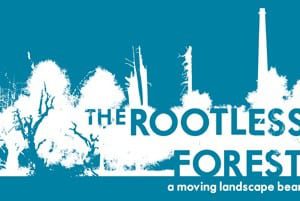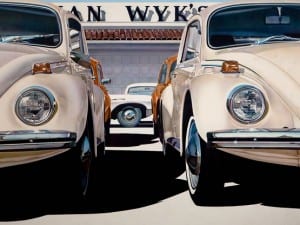North African based artist Yto Barrada’s (winner of the Deutsche Bank’s Artist of the Year 2011) RIFFS is a highly anticipated and significant exhibition for Ikon Gallery.
The exhibition focuses on the complex realities around her, in particular the process of the “new” into a society where the “old” prevails. The title of the show, RIFFS, simultaneously refers to the musical term, to the Cinéma Rif, home of the Tangier Cinémathèque which Barrada directs, and to the nearby Rif mountains, a stronghold of anti-colonial insurgency in Morocco. RIFFS strongly seems to evaluate how “growth” can be metaphorically alluded to through a series of seemingly abstract and banal photographer in her home town. Incorporated into this are two video pieces and a rather intriguing sculptural form.
Upon entering the exhibition, visitors are greeted by a concaving mural/collage haphazardly applied to the wall. This work combines illegible text and blown-up and pixelated imagery to the effect that the viewer gains an awareness of what the actual exhibition space will hold.
Greeted by the first of two video pieces, the room is flooded by a film of people who at first glance, are trying their hardest to save a palm tree from falling. They dig a hole around its base and fill it with concrete. Upon further reading the reality of the situation becomes clear: these people are trying to save the palm tree from falling but a developer has fatally wounded the tree and wants to get rid of it to develop the area in order to build condominiums in its place. Thus the developer is destroying the previous existence of the island, fracturing its historical and natural beauty and in doing so the relationships as a communal land in favour of the modern way of exploiting the land for money and self-gain. Opposite and directly in the path of the viewer is a solid steel sculpture of a palm tree painted white, complete with coloured light bulbs surrounding the drooping leaves. Upon realising the relevance of the palm tree, there is a sense that it is an all too obvious and forced metaphor bleeding the video of its credibility.
The second room is bare, very bare. The walls are white but by no means pristine; they harbour the scars and hallmarks of years of weathering and abuse that is somewhat more visible now than in previous exhibitions. Despite this it may have been a conscious effort; the gritty raw existence of the walls elaborates and adds a new dimension to the work and the theme. The second room is moderately filled with large photography. Some of which it is obvious as to how and where it fits in to the theme, others are more aloof and seemingly exist to add obscurity and a purely abstract aesthetic to the viewer. For example Red Walls (2011) shows two buildings under construction, however the angle at which the picture is taken catches the buildings as mere geometric shapes emphasised by this quite unbelievable redness of the bricks boldly slicing through the pale blue afternoon sky and sun drenched dust road. Hole in The Wall (2011) shows a small child bent down curiously peering through a hole in a wall almost as if it were the pathway, or a glimpse into some new and untold world. This highlights a theme that Yto Barrada is examining in this piece, that at this time the generation of this child will be the ones suffering at the hands of this false, self-motivated “evolution” of Tangier.
Accompanying this explicit social commentary is perhaps the most intriguing photograph in the exhibition, Tunnel (interrupted project under the sea) (2011). The composition of this work is aesthetically brilliant. Showing a close up shot of a grey tattered and textured oil platform dissecting the pristine blue ocean, Barrada’s decision to place the platform aggressively through the middle of the picture is well thought out and effective. Just above the strip of blue sits a slightly clouded pale blue sky that is reminiscent of faded denim. On top of this is the structure of the red rust encrusted platform that imposes and invades the Rothko-esq background like a fly in a drink, sitting awkwardly above the natural background and adding conflict to the resolution of the whole image.
In the final room there is another video, a projection, Hand-Me-Downs (2011) this time documenting 16 myths based upon bona-fide stories passed down through generations including a look in to Yto Barrada’s own family history. However, the grainy picture quality and back and forth between colour and black and white reads like a poorly structured story. The title and corresponding imagery and sound, without reading up about the film, fail to make any obvious connection, made even more impossible in this case as it is entirely in French. Although once this has been divulged one could begin to think that perhaps here the pieces are too self-orientated and they don’t work in quite the harmony Yto Barrada was possibly aiming to create.
Yto Barrada: RIFFS, 16/05/2012 until 08/07/2012, Ikon Gallery, 1 Oozells Square, Brindleyplace, Birmingham, B1 2HS. www.ikon-gallery.co.uk
Cinémathèque de Tanger
To coincide with this exhibition Ikon also presents Cinémathèque de Tanger which sees the Ikon Youth Programme’s Slow Boat converted into a floating cinema. For more information please click here.
Text: William Davie
Credits:
1. Yto Barrada La Cage aux singes (Monkey Cage) (2008/2011)Yto Barrada Briques (Bricks) (2003/2011)
2. Yto Barrada Film still from Hand-Me-Downs (2011) DVD, colour, sound. Courtesy Cinememoire.net
3. Yto Barrada Briques (Bricks) (2003/2011)
All Courtesy Yto Barrada & Galerie Sfeir-Semler Hamburg/Beirut




